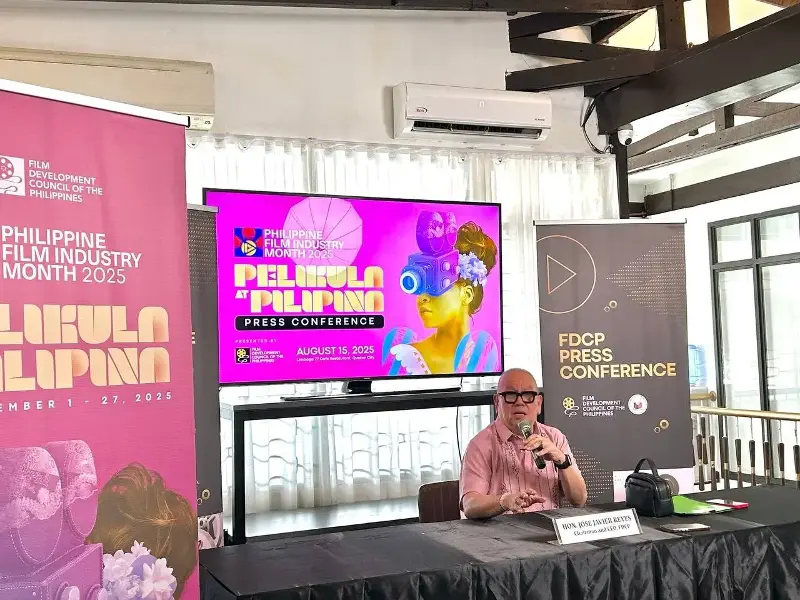
MANILA, Philippines – “This year, we’re celebrating the Filipina,” filmmaker Jose Javier Reyes, chairman of the Film Development Council of the Philippines (FDCP), said at a media conference.
“And these are the Filipinas who have contributed not in front of the camera alone, but also behind the camera,” he added.
Philippine Film Industry Month (PFIM) 2025 rolls out this September with tributes, screenings, workshops, and launches that all circle back to one idea: Women have never been, and must never be, peripheral to Philippine cinema.
Reyes pointed out that many of the country’s biggest film companies are matriarchies, and PFIM leans into that fact, honoring female icons, honoring art from the past, and passing the torch to students and audiences across the country.
Remembering women, reclaiming memory
The celebration opens with two of the brightest stars on the big screen. A digitally restored Ikaw Ay Akin, starring the late National Artist for Film Nora Aunor and the Star for All Seasons Vilma Santos, kicks off PFIM on September 1 at Shangri-La’s Red Carpet Cinemas.
It channels the visage of these female film icons for a statement opener — women reclaiming their power in front of the camera, restored in full clarity for today’s audiences.
Tribute screenings follow in Metro Manila and other regions, spotlighting honorees Lee Briones-Meily (Tanging Yaman), Raquel Villavicencio (Hihintayin Kita sa Langit), Gina Alajar (Moral), Olivia Lamasan (Madrasta), and Malou Santos (Anak).
Each name recalls a distinct role in filmmaking — writer, production designer, director, producer, actor — and together they sketch a lineage of women who, according to Reyes, “are representatives of the Filipinas sa pelikula (in film).”
PFIM also delves into the technical work that goes into preserving memory. From September 24–26, the FDCP joins forces with MOWELFUND Film Institute and the Society of Filipino Archivists for Film for a three-day workshop on audiovisual archiving.
These sessions are about passing down a perhaps precarious and hard-earned knowledge relevant in the wake of Sagip Pelikula’s closure: how to keep fragile reels alive and ensure the stories don’t vanish with time.
A cinema of students and regions
PFIM also insists on an ethos for the future, staking ground on where new filmmakers might take the form. “Marami pa kaming mga ibang plano na parating. (We have many other upcoming plans.) More seminars, more workshops, and hopefully more film students,” Reyes said.
That forward thrust is clearest in the 8th Sine Kabataan Youth Lab and Festival, set for September 5 to 7 at Shangri-La Plaza. Ten filmmakers, all in their teens and twenties, premiere shorts that speak to the realities of their own generation.
Training is not being kept inside the capital either. As a small breach in Manila’s monopoly on resources, Netflix and the FDCP bring masterclasses to Alaminos, Pangasinan, and Iloilo on September 9 and 11, respectively.
Another slot opens on September 13 and 14 at SM North EDSA, where the new Films for Peace competition presents shorts built around the question of cinema as a tool for understanding conflict.
“I’ve seen all of them. Ang gaganda ng interpretasyon nila kung ano ang ibig sabihin ng (They have beautiful interpretations on the meaning of) film being used for a greater understanding of peace. Mayroong mga kaso ng mga (There are cases of) foundlings, illiterate people and how they’re being taught…. Highly diverse,” Reyes said.
On September 25, the FDCP and the Directors’ Guild of the Philippines stage a student pitching showcase. The format is blunt: producers sit across from students in a speed-dating setup, and dream projects are put on the table in minutes.
The pressure is intentional, as the point is to collapse the distance between gatekeepers and the youngest of the field to show that access is neither a gift nor mercy to be received, but a space that can be organized and demanded.
Closer to every Juan
Beyond its tributes and preservation work, PFIM makes another case for accessibility. The festival insists that film is not just for scholars or cinephiles, but for anyone willing to sit down in a theater.
That spirit drives the anticipated return of Pelikula ng Bayan’s Sine50, offering mall screenings of indie films for only P50.
“All of these are niche films which may not have had a grand commercial release, but we’re showing them for P50,” Reyes said. At SM Mall of Asia, TriNoma, Robinsons Galleria Ortigas, and Gateway, audiences can catch a spread of indie standouts like Big Night!, Dagitab, Miss Bulalacao, Apocalypse Child, Patay na si Hesus, and Gusto Kita with All My Hypothalamus.
On September 10, Antoinette Jadaone’s Love You to the Stars and Back lights up Intramuros at Baluarte de San Diego. The past slips back into the projector light as classics follow suit: screenings of Lamberto Avellana’s Anak Dalita (September 12, Fort Santiago) and Marilou Diaz-Abaya’s Brutal and Karnal (September 5, Intramuros) allow their classic dramas to ricochet of the old city’s stone walls.
The penultimate Film Friday of PFIM will be screening a restored version of Gerardo de León’s Sisa on September 21 at the Metropolitan Theater, its madness and melody intact for a new generation of viewers.
“Ang maganda doon (What’s beautiful about this),” Reyes said of cinema in Intramuros, “is we’re using all these historical spots and repurposing them for the young generation to make use of and see.”
The push for wider access also goes online. JuanFlix, the FDCP’s streaming platform, relaunches at the PFIM Closing Ceremony on September 27, at Robinsons Manila, with a new mobile app, fresh interface, and improved reach.
The rollout ties back to the larger theme running through PFIM’s annual editions: Aafilm industry and Philippine cinema given strength by its multiplicity, at once glamorous and grassroots, historical and pioneering, and comfortable in the archive as it is in the everyday. – Rappler.com
Angela Divina is a Rappler intern studying Bachelor of Fine Arts in Creative Writing at the Ateneo de Manila University.
